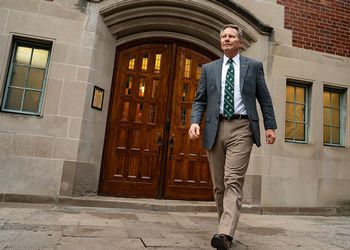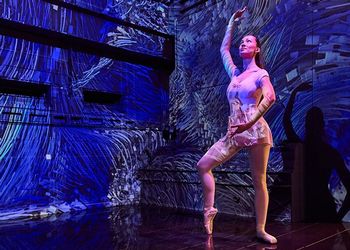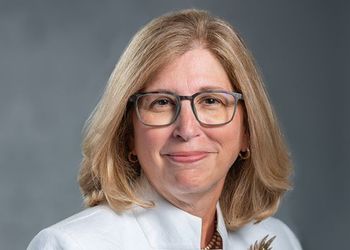Feature: A Cultural Transformation the Eli and Edythe Broad Museum

MSU’s newest cultural center overturns conventions with both its striking architecture and the cutting-edge art exhibitions it will make possible, ushering in a new era of cultural significance for Michigan State University.
The bold, strikingly unique steel-clad structure that now stands near the intersection of Grand River Avenue and Farm Lane is more than just a radical new addition to the architectural landscape of Michigan State University and the City of East Lansing.
The new Eli and Edythe Broad Art Museum at MSU, which opened to the public in early November, symbolizes a major cultural transformation for the university, the region and the state. The introduction of this important new entity puts MSU, Greater Lansing and all of Michigan on the map as a major center for the study and appreciation of international contemporary art and architecture.
“It will serve as a source of inspiration for our students, faculty and staff, as well as to the community and beyond,” says MSU President Lou Anna K. Simon. “Certainly it will be a cultural hub and architectural landmark both reflecting and generating creativity, which will pay dividends for the community’s prosperity and quality of life far into the future. Its international outlook also will help us extend our global and cultural networks, which is a practical benefit both to the regional artistic community and to our students.”
Pushing boundaries
The beginning of the Eli and Edythe Broad Art Museum dates back to June 2007, when MSU announced that a new art museum would be created thanks to a $26 million donation from longtime MSU supporters and prominent art collectors Eli and Edythe Broad. This development came after a push to expand and enhance MSU’s existing art institution, the Kresge Art Museum, evolved into a plan—spearheaded by MSU President Lou Anna K. Simon—to forge a completely new museum focused on contemporary art.
“This museum owes its birth to the moment that united a visionary leader, Lou Anna K. Simon, and Eli and Edythe Broad, whose philanthropy in the arts, science and education are among the most generous in contemporary America,” says Michael Rush, founding director of the Broad Art Museum at MSU.
An architectural competition ensued in an effort to create a building as inspiring and prominent as the art exhibitions it was meant to house. Meanwhile, President Simon, the Broads and the MSU Board of Trustees selected a location near the intersection of Grand River and Farm Lane—a decision driven in large part by a desire to connect the new museum with the community and to enhance the economic and cultural development of the region at the same time that it transformed the cultural and architectural landscape of MSU’s campus.
Nearly a dozen internationally prominent architectural firms were invited to submit expressions of interest to design the new museum. From that initial list five firms were brought in to present their concepts in July 2007 to an eight-member competition jury consisting of leaders in the arts, education and business sectors.
On January 15, 2008, Pritzker Prize–winning architect Zaha Hadid came to campus for the announcement that her firm, Zaha Hadid Architects, had been selected to design the Eli and Edythe Broad Art Museum at MSU.
“We’ve described this design as symbolizing our trajectory into the future, given the nature of the architecture and the architect we selected,” says President Simon. “We wanted the museum itself to be a great work of art that would house great works of art—a sort of inhabited sculpture that provokes the same sorts of thought and examination as would any other remarkable creation.”
The MSU Board of Trustees authorized construction of the Eli and Edythe Broad Art Museum on December 11, 2009. Shortly thereafter Eli and Edythe Broad donated an additional two million dollars to support the $40 to $45-million construction budget. In March 2010, MSU hosted a groundbreaking ceremony attended by Eli and Edythe Broad, Zaha Hadid, then-Governor Jennifer Granholm, MSU Board of Trustees Chairman Joel Ferguson, and President Simon. And construction began on a 46,000-square-foot structure of stainless steel and glass that from its inception was designed to disrupt convention.
“Museums for art must provide an opportunity for the unknown and untested, and for new technologies and media to be explored,” says architect Zaha Hadid. “The Broad MSU has been designed as a crossroads for the university. Its steel skin appears to change constantly with different light and viewing perspectives—the directional pleats echoing the unique topography and circulation routes of the campus. We have worked hard to ensure light penetrates deep into the museum’s interior—giving tantalizing glimpses into the galleries that will arouse your curiosity.”
New destination for international exploration
The architecture of the new Broad Art Museum at MSU certainly is significant and game-changing for the university and the community. But so too is what’s inside.
“Expressly dedicated to exploring international contemporary culture and ideas through the probing gaze of artists, the Broad MSU is, first, an institution devoted to international contemporary art,” says Michael Rush. “The Broad MSU is a place where artists’ ideas, words and actions will create a vibrant center for questioning and understanding the modern world.”
Rush was selected in November 2010 as the founding director of the Eli and Edythe Broad Art Museum. Prior to his appointment, Rush was the director of the Rose Art Museum at Brandeis University in Boston, where he oversaw a significant collection of modern and contemporary art in the region and was recognized for his leadership during a controversial attempt by the university to sell the collection and close the museum. He also was director of the Palm Beach Institute of Contemporary Art and is a published author on contemporary and video art.
The new museum’s focus on contemporary art is driven in large part by the direction and vision of the museum’s founding donors.
“Over the years, as our passion for collecting art grew, we became even more resolute about sharing contemporary art with as many people as possible,” says Eli Broad. “We have found that the arts uplift and inspire us, but they often also challenge our world view and expose us to new and different perspectives and thinking. Contemporary art is a telling mirror that reflects current social, political and cultural issues. We are particularly engaged by art of our time because we often have the opportunity to meet the artists and hear firsthand about their work and their lives.”
The inaugural exhibitions that made their debut at the museum’s November opening clearly signify the institution’s contemporary and global aims, featuring artists from more than 20 countries, including China, South Korea, Zimbabwe, South Africa, Slovenia, Iran, Vietnam and the Palestinian Territories.
Global Groove 1973/2012, one of the two inaugural exhibitions curated by Michael Rush, features Nam June Paik’s seminal video from 1973, Global Groove, as a jumping off point to explore current trends in international video art. The exhibition will celebrate the multiple approaches to the medium of video art and is housed in a unique, architectural display in one of the museum’s second-floor galleries.
Another inaugural exhibition, In Search of Time, seeks to explore the longing artists have held for hundreds of years to express their relationship to time and memory. By creating dialogues among artworks from the medieval period, the nineteenth, twentieth and twenty-first centuries, the exhibition gives voice to a motif that artists have shared for hundreds of years.
In Search of Time accomplishes its mission in part by integrating works from one of the Eli and Edythe Broad Art Museum’s great strengths: the historical collection of thousands of works inherited from the Kresge Art Museum, which forms the foundation for an expanded contemporary collection but allows the museum to draw from art history for comparisons and education.
“This collection, which spans cultural production from ancient Greece and Rome and pre-Columbian cultures through Medieval and Renaissance art to the modern and contemporary, will enable the Broad MSU to explore the art of our time through the long lens of art history,” Rush says.
Other installations put in place for the opening of the museum serve to further extend the global, contemporary and nature of the museum, as well as provide an indication of the varied ways in which art will be presented through video, performance, social commentary and participation.
In the museum’s lower-level new media gallery, visitors don 3D glasses to view Marco Brambilla’s Evolution (Megaplex) video, which recounts the entire history of human evolution illustrated as a vast side-scrolling video mural. Upstairs, Iñigo Manglano-Ovalle has installed a monumental sculpture called Red Factor that references the work of Buckminster Fuller, suspended by cable and extending up into the 32-foot-high reaches of the museum’s main gallery.
The global theme echoes nearby, where Marjetica Ptroc’s Soweto House with Prepaid Water Meter takes a probing look at housing situations and solutions in currently or formerly unplanned cities. Just upstairs, Chen Qiulin’s installation of suspended bodies reflects those lost in the floods of the massive Three Gorges project in China. Nearby, Vietnamese artist Nguyen Phuong Linh’s two-ton sculpture of a boat made entirely of salt references both migration and daily living in her native country.
In the museum’s sculpture garden outside the east entrance, Roxy Paine’s Containment 1, donated by Eli and Edythe Broad, is part of his Dendroid series of life-size stainless steel trees. Nearby, Sloth Pieta by Steve Miller is one of a series of x-ray images of animals celebrating Brazil’s biodiversity. Jonathan Prince’s Vestigial Block is a 3,250-pound sculpture made of hand-worked stainless steel.
Engaging—and enhancing—the community
Just inside the sculpture garden is the museum’s education wing, which currently houses the exhibition Fritz Haeg: Domestic Integrities. Creation of the work began in early September 2012 with the participation of MSU students and the entire community. Intended to explore local patterns and rituals of interior domestic landscapes, the work’s centerpiece is a circular woven rug that was created in part by collaborating local groups who gathered to weave and brought something they have cooked or produced from elements harvested or found in the area.
The Fritz Haeg exhibition, overseen by Alison Gass, curator of contemporary art for the Broad MSU, along with education director Aimee Shapiro, is indicative of the kind of project designed to engage and involve the community—one of the hallmarks of the new museum. Efforts to that end began well in advance of the museum’s opening, with the introduction of family events, concerts and other initiatives that—like admission to the museum itself—are free to MSU students and the general public alike.
“The museum’s programming will engage every possible audience—simultaneously exploring the specifics of this place and broadening to illuminate the conditions of diverse communities around the globe,” Gass says. “This expansive focus mirrors the ways in which local issues confronting us in East Lansing and throughout the United States impact and echo the challenges facing a global community.”
According to a recent study conducted by Lansing-based Anderson Economic Group, the Broad Art Museum at MSU is expected to draw approximately 150,000 attendees annually. The study projects that approximately 30,000 (or 20 percent of the total annual attendance base) will be new visitors who travel to the area specifically for the museum.
The same study projects that museum visitors will contribute an estimated $5.75 million in new annual expenditures to the region—ranging from shopping and entertainment to hospitality, transportation and lodging. That means the Eli and Edythe Broad Art Museum not only will be contributing to a cultural transportation of the region, but also will make a significant economic impact—all of which began with a gift from two of MSU’s most generous supporters.
“The Broads’ generosity and vision will have tremendous positive impact on Michigan State, our community, and our students for generations to come,” says President Simon. “If you think about really supporting innovation on this campus and in this state, this kind of alumni and stakeholder support supplies leverage that can be so pivotal to how much we’re able to do to fulfill our mission in this more globally competitive, yet financially constrained, age.”
Jason Meyers was director of communications and a member of the founding staff of the Eli and Edythe Broad Art Museum at MSU. He is a longtime journalist and communications professional and a 1988 graduate of MSU’s School of Journalism.
SUPPORT FOR A NEW CULTURAL LANDMARK
The Eli and Edythe Broad Art Museum is a gift to the MSU community from the founding donors, who made the museum a reality. The museum is prospering thanks to donors at every level—from ten dollars to $28 million—including corporate partners and generous members of the community.
That philanthropic spirit has helped support the museum’s construction, opening events and inaugural exhibitions—but it is only the beginning. As an institution that is free and open to the public, the Broad Art Museum at MSU is relying on the ongoing support of the MSU community to become members and otherwise financially support the museum.
“Membership and donations help make it possible for us to attract major exhibitions and collections, create valuable educational programs for all ages and enrich the experience of art for generations to come,” says Marcia Crawley, director of development for the Broad MSU. “By supporting this world-class museum, you are making an investment in an extraordinary new era of the arts.”
Contributions to the Eli and Edythe Broad Art Museum Annual Fund support a wide range of needs, including:
? The daily operation and maintenance of the museum.
? Educational programming for all ages—including family days, artist talks, films and performances and a docent program that brings art to schools and schools to the museum.
? Visitors, educators, curators, programs and activities that increase visitors’ connection with contemporary art.
? Conservation and expansion of the museum’s collection of historical and contemporary art.
The museum offers a variety of opportunities for corporations to support exhibitions, educational programs and special events through targeted sponsorships, and for individuals to support the institution through contributions and membership. for more information, visit broadmuseum.msu.edu/join
“Communities thrive when dynamic opportunities, arts and culture combine to create a vibrant, exciting place,” Crawley says. “Michigan is poised to become exactly one of those places and the Eli and Edythe Broad Art Museum is leading the way. We are grateful to our generous donors and supporters who help the museum share our exhibitions, collections, and programs with visitors from around the world.”



